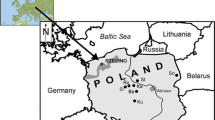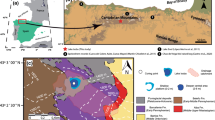Abstract
Sedimentological climate proxies and a 200-year long climate record, reconstructed using a data-set of European-wide meteorological data, have been compared at the high mountain lake Nižné Terianske pleso in the High Tatras, Slovakia. Diatoms, chrysophyte stomatocysts, chironomids, plant pigments and spheroidal carbonaceous particles (SCPs) were analysed as well as sediment lithostratigraphic parameters. Using a radiometric approach the sediment core was dated and a depth of 4.6 cm was found to correspond to 1852 AD. The sediment accumulation rate (0.0034 g·cm−2·yr−1) was one of the lowest identified in the European mountain lake project, MOLAR. Despite this slow accumulation rate a remarkably coherent lithological and stratigraphic record has been recovered. The sediments of this remote mountain site, largely free from the effects of direct human impact, have been found to display a wealth of variability over the last 200 years.
The record of spheroidal carbonaceous particles, indicators of anthropogenic pollution deposition, begins around 4.5–5.0 cm in depth (1833–1857). Temporal patterns are typical of European lake sites with the concentration peaking in the late 1970's. The SCP/210Pb inventory ratio for the site is also in good agreement with the European latitudinal pattern. A strong influence of sample age on the chrysophyte assemblage composition in the upper-most 4–6 cm indicates that the main changes in the cysts have been related to long term environmental changes, probably pH. Analysis of chironomid remains revealed a stable profundal community. Chironomids as a whole showed no correlations to temperature fluctuations in the last 200 years. Relatively abundant remains of Diamesa sp. head capsules and other taxa closely associated with stream conditions in the older layers contrast with the absence of Diamesa sp. in the recent sediments. This change is considered to be evidence for the existence of a stronger, more stable inlet supplied from permanent granular snow fields in the lake basin. The most important changes in diatom assemblages were observed at 3cm. Many species of the genus Achnanthes spp. together with Navicula schmassmannii and Orthoseira roeseana made up the greatest part of the diatom community above 3 cm, being absent or rare lower in the record. A positive correlation between diatoms and mean summer temperature was found.
Similar content being viewed by others
References
Agbeti, M. D. & J. P. Smol, 1995. Chrysophyte population and encystment patterns in two Canadian lakes. J. Phycol. 31: 70-78.
Agustí-Panareda, A. & R. Thompson, 2002. Reconstructing air temperature at eleven remote alpine and arctic lakes in Europe from 1781 to 1997 AD J. Paleolim. 28: 7-23.
Appleby, P. G., 1993. Forward to the 210Pb dating anniversary series. J. Paleolim. 9: 155-160.
Appleby, P. G., 1998. Dating recent sediments by 210Pb: Problems and solutions. Proc. 2nd NKS/EKO-1 Seminar, Helsinki, 2-4 April 1997.
Appleby, P. G., 2000. Radiometric dating of sediment records in European mountain lakes. J. Limnol. 59(suppl. 1): 1-14.
Appleby, P. G., P. J. Nolan, D. W. Gifford, M. J. Godfrey, F. Oldfield, N. J. Anderson & R. W. Battarbee, 1986. 210dating by low backgroud gamma counting. Hydrobiologia 141: 21-27.
Appleby, P. G. & F. Oldfield, 1978a. The calculation of 210Pb dates assuming a constant rate of supply of unsupported 210Pb to the sediment. Catena 5: 1-8.
Appleby, P. G. & F. Oldfield, 1978b. The assessment of 210Pb data from sites with varying sediment accumulation rates. Hydrobiologia 103: 29-35.
Appleby, P. G. & F. Oldfield, 1983. The assessment of 210Pb data from sites with varying sediment accumulation rates. Hydrobiologia 103: 29-35.
Appleby, P. G., N. Richardson & P. J. Nolan, 1991. 241Am dating of lake sediments. Hydrobiologia 214: 35-42.
Appleby, P. G., N. Richardson & P. J. Nolan, 1992. Self-absorption corrections for well-type germanium detectors. Nucl. Inst. Meth. B 71: 228-233.
Barber K. E., R. W. Battarbee, S. J. Brooks, G. Eglington, E. Y. Haworth, F. Oldfield, A. C. Stevenson, R. Thompson, P. G. Appleby, W. E. N. Austin, N. G. Cameron, K. J. Ficken, P. Golding, D. D. Harkness, J. A. Holmes, R. Hutchinson, J. P. Lishman, D. Maddy, L. C. V. Pinder, N. L. Rose & R. E. Stoneman, 1999. Proxy records of climate change in the UK over the last two millennia: documented change and sedimentary records from lakes and bogs. J. Geol. Sci. Lond. 156: 369-380.
Battarbee, R. W., 1986. Diatom analysis. In: Berglund, B. E. (ed.)., Handbook of Holocene Palaeoecology and Palaeohydrology. John Wiley & Sons, Chichester, 527-570.
Battarbee, R. W., 2000. Paleolimnological approaches to climate change, with special regard to the biological record. Quat. Sci. Rev. 19: 107-124.
Battarbee, R. W. & M. J. Kneen, 1982. The use of electronically counted microspheres in absolute diatom analysis. Limnol. Oceanogr. 27: 184-188.
Battarbee, R. W., J.-A. Grytnes, R. Thompson, P. G. Appleby, J. Catalan, A. Korhola, H. J. B. Birks, E. Heegaard & A. Lami, (2002). Comparing palaeolimnological and instrumental evidence of climate change for remote mountain lakes over the last 200 years. J. Paleolim. 28: 161-179.
Bitušík, P. & V. Kubovčík, 1999. Sub-fossil chironomids (Diptera: Chironomidae) from the sediments of the Ni·né Terianske pleso (High Tatra Mts., Slovakia). Dipterologica bohemoslovaca 9: 11-20.
Brooks, S. J., 1997: The response of Chironomidae (Insecta: Diptera) assemblages to late-glacial climatic change in Kråkenes lake, Western Norway. Quart. Proc. 5: 49-58.
Brundin, L., 1956: Die bodenfaunistischen Seetypen und ihre Anwendbarkeit auf die Südhalbkugel. Report Institute Freshwater research, Drottningholm, 37: 186-235.
Catalan, J., S. Pla, M. Rieradevall, M. Felip, M. Ventura, T. Buchaca, L. Camarero, A. Brancelj, P. G. Appleby, A. Lami, J. A. Grytnes, A. Agustí-Panareda & R. Thompson, 2002. Lake Redó ecosystem response to an increasing warming in the Pyrenees during the twentieth century. J. Paleolim. 28: 129-145.
Cleveland, W. S., E. Grosse & W. M. Shyu, 1993. Local regression models. In Chambers, J. M. & T. J. Hastie (eds), Statistical Models in S Chapman & Hall, London, 309-376.
Duff, K. A., B. A. Zeeb & J. P. Smol, 1995. Atlas of Chrysophycean Cysts. Kluwer Academic Publishers, Dordrecht.
Facher, E. & R. Schmidt, 1996. A silicious chrysophycean cyst-based pH transfer function for Central European lakes. J. Paleolim. 16: 275-321.
Fritz, S. C., 1996. Paleolimnological records of climatic change in North America. Limnol. Oceanogr. 41: 882-889.
Glew, J. R., 1989. A new trigger mechanism for sediments samplers. J. Paleolim. 2: 241-243.
Guilizzoni, P., G. Bonomi, G. Galanti & D. Ruggiu, 1983. Relationship between sedimentary pigments and primary production: evidence from core analyses of twelve Italian lakes. Hydrobiologia 103: 103-106.
Kamenik, C., R. Schmidt, K. Koinig, A. Agustí-Panareda, R. Thompson & R. Psenner, 2002. The Chrysophyte stomatocyst composition in a high alpine lake (Gossenköllesee, Tyrol) in relation to seasonality, temperature and land-use. Beih. Nova Hedwigia (in press).
Kowalyk, H. E., 1985: The larval cephalic setae in the Tanypodinae (Diptera: Chironomidae) and their importance in generic determinations. Can. Entomol. 117: 67-106.
Krno, I., 1991. Macrozoobenthos of the Tatra lakes littoral (The High Tatras) and its effection by acidification. Biologia (Bratislava) 46: 495-508.
Lami, A., F. Niessen, P. Guilizzoni, J. Masaferro & C. A. Belis, 1994. Palaeolimnological studies of the eutrophication of volcanic Lake Albano (central Italy). J. Paleolim. 10: 181-197.
Lami, A., P. Guilizzoni, A. Marchetto, 2000. High resolution analysis of fossil pigments, carbon, nitrogen and sulphur in the sediment of eight European alpine lakes: the MOLAR project. J. Limnol. 59(suppl. 1): 15-28.
Lotter, A. F., H. J. B. Birks, W. Hofmann & A. Marchetto, 1997. Modern diatom, cladocera, chironomid, and chrysophyte cyst assemblages as quantitative indicators for the reconstruction of past environmental conditions in the Alps. I. Climate. J. Paleolim. 18: 395-420.
Rose, N. L., 1994. A note on further refinements to a procedure for the extraction of carbonaceous fly-ash particles from sediments. J. Paleolim. 11: 201-204.
Rose, N. L., S. Harlock, P. G. Appleby & R. W. Battarbee, 1995. The dating of recent lake sediments in the United Kingdom and Ireland using spheroidal carbonaceous particle concentration profiles. Holocene 5: 328-335.
Rose, N. L., S. Harlock & P. G. Appleby, 1999. The spatial and temporal distributions of spheroidal carbonaceous fly-ash particles (SCP) in the sediment records of European mountain lakes. Water, Air Soil Pollut. 113: 1-32.
Sæther, O. A., 1975. Nearctic chironomids as indicators of lake typology. Verh. Int. Ver. Limnol. 19: 3127-3133.
Smoleň, F. & M. Ostrožlík, 1991. Biometeorological cooling at high Mountain positions under various meteorological conditions. In Mountainous Meteorology, Climatology and Aerology of the Lower Layers of Troposhere., Bratislava, SHMI, 159-165
Stuchlík, E., Z. Stuchlíková, J. Fott, L. Růžicka & J. Vrba, 1985. Effects of acid precipitations on waters of the TANAP territory. Zborník TANAPu, 28: 173-211.
Wathne, B. M. & B. O. Rosseland (eds), 2000. MOLAR-Measuring and modelling the ynamics response of remote mountain lake ecosystems to environmental change: a program of Mountain Lake Research-MOLAR. Final Report 4/1999. Norwegian Institute for Water Research (NIVA), 201 pp.
Wiederholm. T. (ed.), 1983. Chironomidae of the Holarctic region. Keys and diagnoses. Part 1. Larvae. Ent. Scand. Suppl. 19: 1-457.
Züllig, H., 1985. Pigmente phototropher Bakterien in Seesedimenten und ihre Bedeuntung für die Seenforschung. Schweiz. Z. Hydrol. 47: 87-126.
Author information
Authors and Affiliations
Rights and permissions
About this article
Cite this article
Šporka, F., Štefková, E., Bitušík, P. et al. The paleolimnological analysis of sediments from high mountain lake Nižné Terianske pleso in the High Tatras (Slovakia). Journal of Paleolimnology 28, 95–109 (2002). https://doi.org/10.1023/A:1020376003123
Issue Date:
DOI: https://doi.org/10.1023/A:1020376003123




